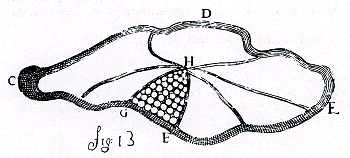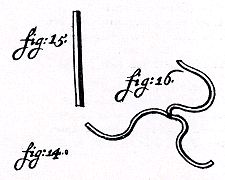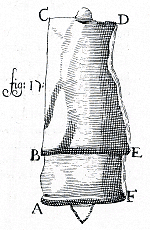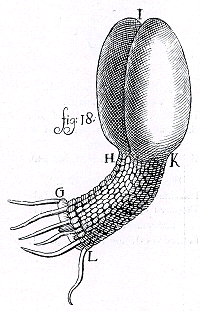Plaat XXVI.
Table XXVI.

Afb. 41. Hazelnoot (Corylus avellana L.). 1,3 ×.
a. noot in zijaanzicht; b. noot van onderen gezien; c. lengtedoorsnede door de noot, de aanhechting van het zaad tonend, de resten van het tussenschot zijn niet aangegeven; d. zaad met aanhechtingsstreng; e. idem, maar met tussenschotresten en geaborteerd ovulum (f).
Brief 85(46), 13 Juli 1685, blz. 240 en 242, aant. 60, 64 en 65.
Ill. 41. Hazelnut (Corylus avellana L.)., × 1,3.
a. side-view of nut; b. nut as seen from below; c. longitudinal section through the nut, showing attachment of seed. The rest of the septum is not shown; d. seed with attachment cord; e. ditto, but with rests of septum, and an abortive ovule (f).
Letter 85(46), July 13, 1685, pp. 241 and 243, notes 36, 38 and 39.

fig. XLVII (= 13 L.). ‘Streng waar door de amandel gevoet wert, overdwars doorgesneden’.
Brief 85(46), 13 Juli 1685, blz. 244.
Fig. XLVII (= fig. 13 L.). ‘Cord through which the almend was nourished, cut through on the cross.’
Letter 85(46), July 13, 1685, p. 245.

fig. XLVIII, XLIX, L (= fig. 14, 15, 16 L.).
Zaadpluis (katoen) van de wilg (Salix alba L.)
Brief 85(46), 13 Juli 1685, blz. 256, 258.
Figs XLVIII, XLIX and L (= figs 14, 15, 16 L.).
Tuft of hairs (cotton) of the willow (Salix alba L.).
Letter 85(46), July 13, 1685, pp. 257 and 259.

fig. LI (= fig. 17 L.). Ingedroogd zaad van de wilg (Salix alba L.). Het gedeelte ABEF correspondeert met de ringvormige wal van de radicula (zie afb. 45 en 46).
Brief 85(46), 13 Juli 1685, blz. 258, 260.
Fig. LI (= fig. 17 L.). Willow (Salix alba L.). Dried-up seed. The part ABEF corresponds to the ring-shaped wall of the radicle (see illustrations 45 and 46.
Letter 85(46), July 13, 1685. pp. 259 and 261.

fig. LII (= fig. 18 L.). 36 uur oude kiemplant van de wilg (Salix alba L.). De cotyledonen, de hypocotyle as en het kiemworteltje (met zijworteltjes) zijn duidelijk te herkennen.
Brief 85(46), 13 Juli 1685, blz. 260,
Fig. LII (= fig. 18 L.). A 36-hour-old embryo of the willow (Salis alba L.). The cotyledons, the hypocotyl axis and the radicle (with small side-roots) are clearly recognizable.
Letter 85(46), July 13, 1685, pp. 261.